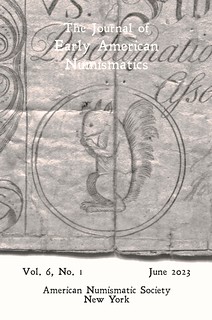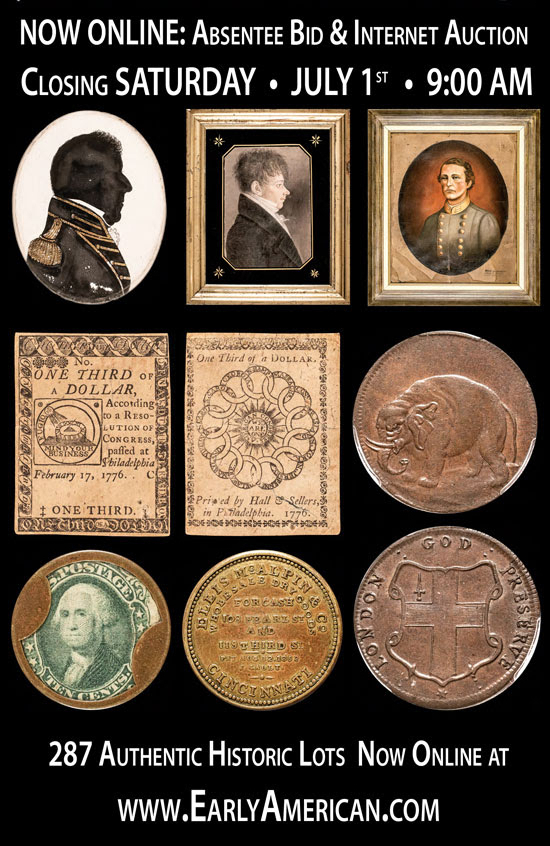
PREV ARTICLE
NEXT ARTICLE
FULL ISSUE
PREV FULL ISSUE
JOURNAL OF EARLY AMERICAN NUMISMATICS V6N1The latest issue of the Journal of Early American Numismatics (JEAN) has been published. Editor Chris McDowell shared this summary. Thanks. -Editor
Gary has two articles in this issue. His second offering, The third article in this issue is exceptional, as well as being particularly timely. A general rule of numismatics is that as the price of coins and medals increases, many people begin to explore other areas for intriguing numismatic bargains. This truism has remained constant throughout my collecting lifetime. My good friend Bruce Smith showed me his collection of sewn, pinned, and backed colonial notes a half-dozen years ago. Ye Editor was fascinated. At first glance, they were unimpressive—appearing to be something more akin to an assemblage of damaged notes than a sophisticated collection—but upon closer examination their pragmatic handiwork and diversity of backings draws you to a world where good old-fashioned Yankee know-how and pragmatism extended the longevity of notes through every means possible. I was particularly drawn to the backed specimens. Each backed note is a historical time capsule waiting to be opened. While I was able to dodge the siren song of these numismatic treats and keep from crashing on the rocks of another series, I began helping Bruce by notifying him when I saw them on eBay. Initially, they sold for prices reflective of their first blush appearance as torn and damaged notes, which they technically are. But soon enough, savvy collectors began to take note of their inner beauty, and the prices started increasing, eventually overtaking the prices for undamaged notes. My good friend apparently got in on the ground floor of a trend. Timing is everything.
Recently, the Colonial Coin Collectors Club (C4) began having table discussions at our
convention in Baltimore, where colonial coins, medals, and notes are shared and studied (we call
the event a JEAN's editors and contributors strive to embrace the essential Spanish colonial coinages into each of our issues. I am pleased that Philip Ellsworth has contributed an invaluable article on South American assayers for this issue. As my numismatic interest turns to medals produced in Central and South America, I have come to a greater appreciation of the importance and difficulties in researching these Spanish colonial coinage topics. Philip's article is essential for those interested in learning more about the New World's first mints. Roger Moore has produced a delightfully offbeat and entirely refreshing article on alcohol in pre-federal America. Although the piece has a numismatic connection, it is designed for readers interested in the specifics and designs of the money in circulation in early America and also in the daily lives of those who minted and spent the coins we collect. Like it or not, our ancestors were heavy drinkers. The history of alcohol is the history of modern man. In eighteenth-century Europe, drinking water was a risky undertaking. One can only imagine the putrid stench that hung in the urban air emanating from open sewers draining directly into streets and waterways. America was different. It was an unspoiled wilderness of fresh flowing streams. Nonetheless, our forefathers only grudgingly drank water, and then only because they lacked a ready supply of the good stuff from Europe. The rise of alcohol consumption tracks closely with the rise of American cities, commerce, and industrialization. But it was not all wassail and toddy. The fact of the matter is that many of our Revolutionary ancestors spent much of their day in a state of slight to moderate inebriation. What impact did this have on the production of coins? Roger helps answer this question in this high-spirited article. The last, but not least, of our feature articles, comes to us from our good friend Jeff Rock. This is the conclusion of his series on Auctori Plebis tokens. Jeff brings the topic to a close with a bang. JEAN exists to publish articles like this. Numerous numismatic themes are unsuitable for a book, too complex for a short C4 Newsletter article, and too long for placement in other numismatic periodicals. If it were not for JEAN, these articles would go unpublished, unexplored, and perish. I am pleased to preserve Jeff's wisdom for posterity on these pages. Our readers love Jeff's writing style, and his many followers will not be disappointed with this piece, which corrects generations of errors and finally and conclusively resolves the mysteries behind these tokens. There is no doubt that Jeff's articles on the Auctori Plebis series shall be THE seminal work in this area for generations. JEAN has published book reviews in the past, and we plan to make them a regular feature. This issue concludes with a review prepared by Dr. Jesse Kraft, a man of great discernment, outstanding taste, and trusted numismatic wisdom. We are living in the Golden Age of colonial numismatic research and writing. Future generations will look back on us with envy and wonder. We have yet to reach the apex of what is possible.
CONTENTS
Editor's Preface
The Life and Character of Albion Cox
Scraps from Yankee Doodle's Wastebasket:
A Look Back at Colonial Currency
The First Spanish Colonial Assayers in South America
Alcohol in Pre-Federal America:
A Cause for Minting and Printing Errors?
The Mysterious Auctori Plebis Tokens, Part Two:
The Evasion Coppers
Book Review
The Early Betts Medal Companion: Medals of America's
Discovery and Colonization (1492–1737)
To subscribe, see:
Wayne Homren, Editor The Numismatic Bibliomania Society is a non-profit organization promoting numismatic literature. See our web site at coinbooks.org. To submit items for publication in The E-Sylum, write to the Editor at this address: whomren@gmail.com To subscribe go to: https://my.binhost.com/lists/listinfo/esylum All Rights Reserved. NBS Home Page Contact the NBS webmaster 
|

